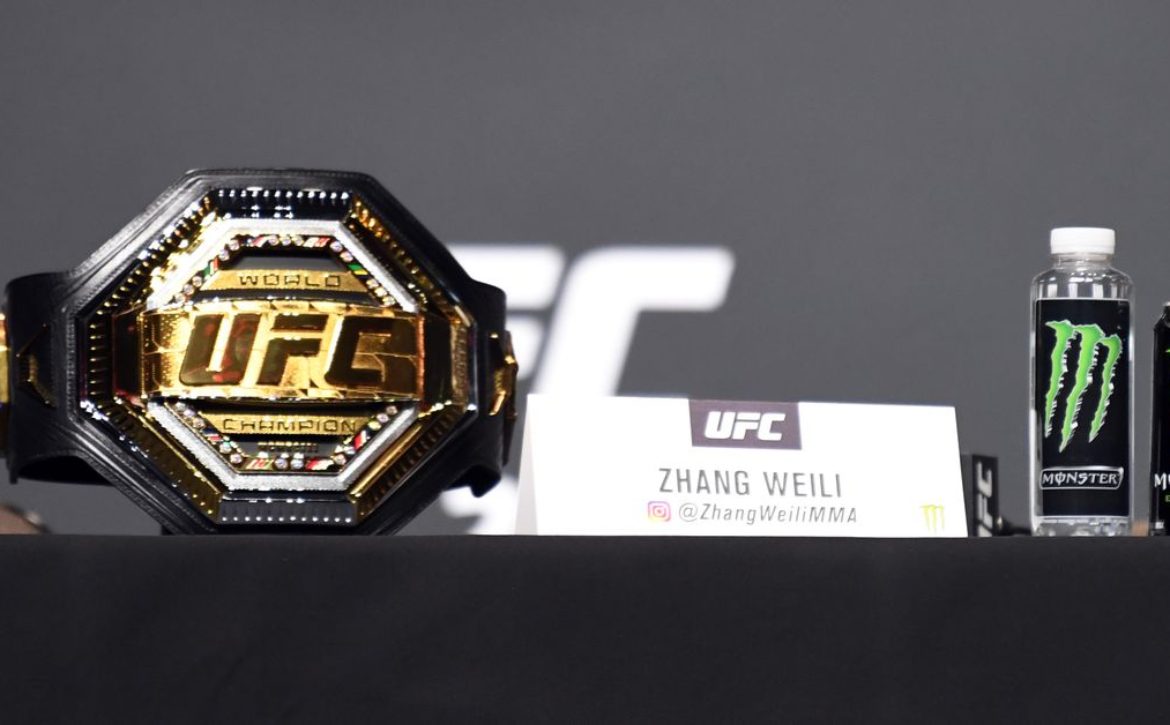
Video: Yes, the UFC is a monopsony
Photo by Josh Hedges/Zuffa LLC
No, really. There has long been a reluctance by fans to acknowledge that the UFC is a monopsony. The reasons for this are numerous, but a major factor is surely that for there is just a general misunderstanding of what is a monopsony. It is because of this misunderstanding that I made the video above.
While most people are familiar with the term monopoly, fewer have heard of a monopsony, which is the opposite of a monopoly. This is where the confusion probably starts, because the definition most people use is the one given by Meriam Webster’s in which a monopoly refers to the sole owner or seller of a product or service. But another definition is provided by the US legal system, where monopoly (also called monopoly power) “is a control or advantage obtained by one entity over the commercial market in a specific area.”
As can be seen, it is not necessary for a company to be the only provider or seller in order to be labeled a monopoly. The definition of monopsony under the legal system is similarly less strict, where instead of being the buyer it is a “situation where one buyer controls the market.”
This lack of awareness of the alternative definition of monopolies and monopsonies leads many fans to passionate deny the UFC is one, for how could they be a monopoly or monopsony when other promotions in existence. But it is not the presence of more than one promotion that determines if a company has monopoly power but instead whether they have the ability to control prices because of their scale and/or control of the market.
Photo by Cooper Neill/Zuffa LLC
A conventional test of monopoly power involves measuring the market share. A company is thought to potentially have market power if they have at least 50 percent or more of a market. According to filings in the UFC antitrust lawsuit the company has a 90% share in both the domestic and international market. So for every one dollar that goes to MMA promotions, 90 cents of that is going to the UFC.
There is also a commonly accepted measure of market concentration called the Herfindahl–Hirschman Index. Industries are scored on a scale of 0 to 10,000 to determine if they are concentrated or not. An HHI of below 1500 is an unconcentrated industry. Anything over 2500 is concentrated. With the UFC having a 90% market share the MMA promotion industry would have a HHI above 8000. In other words a very concentrated market – one that is concentrated around one single firm.
It is not only sales though that the UFC dominates, although that is what likely categorized them as market power. When one looks at the Fight Matrix rankings for the 11 weight classes that the UFC promotes we find that they have the number 1 ranked fighter in all 11 divisions. The UFC also has 88% of all fighters ranked in the top 10 for those weight classes. Even when we expand to the top 25 for each weight class they still have 74% of all the ranked fighters. So easily the vast majority of the top ranked fighters are signed with the UFC. And the few top ranked fighters that are not signed with them are split between several other promotions.
This dominance over the rankings helps explain the UFC’s market position: because there is a correlation between high ranking and interest with the fans. As a general rule, higher “ranked” fighters are more popular and draw more interest than lower ranked fighters. Championship bouts draw even higher interest. Thus higher ranked fighters fighting each other in championship bouts generally matter more than other fights.
This was also the findings of the courts in the United States v. International Boxing Club of New York, in which they stated that because championship bouts generated so much more in sales than non championship bouts they constituted a completely different market.
So if the UFC has the highest number of high ranked fighters plus all the “world champions,” then it’s not too surprising the promotion would also generate the most revenue.
The gap between the UFC and other MMA promoters is perhaps best demonstrated by looking at the amount of revenue generated on average per fighter-bout.
In 2019 the UFC made approximately $860 million and held 517 fights that year. With two fighters competing in each fight there was 1034 fighter-bouts that year. So the average amount of revenue generated for each fighter-bout was just over $830,000.
In comparison, Bellator was projected to see $80 million in revenue in 2019 and held 495 fights — or 990 fighter-bouts — which means the average revenue generated by each fighter bout was just over $80,000.
So the UFC generated ten times as much revenue per fighter bout as their competitor. We also know from the antitrust lawsuit that the wage share or compensation for all the UFC fighters averaged around 20% of all their revenue, while for Bellator it averaged around 45% during the class period. Based on that wage share, the average UFC fighters pay per bout was almost 5 times as much as the average Bellator fighters compensation.
What that means is Bellator could pay 100% of their revenue to their fighters and still not match the average pay per UFC fighter.
And the other MMA promoters generate even less sales per fighter-bout as Bellator, making the gap with them even wider.
Photo by TASSTASS via Getty Images
The solution would seem that these other promotions need to develop more high ranking fighters who would then increase interest in their promotions and thus increase their revenues. The problem with this plan is that it takes a higher ranked fighter to make a higher ranked fighter. In many ways rankings are like a ladder, and a fighter can only move up rankings by competing against fighters higher up the rungs. If all the top ranked fighters in their division has signed with one promotion then that fighter will also have to sign with that promotion if they wants a chance to rise in the rankings.
UFC generated ten times as much revenue per fighter bout as their competitor
This is an example of the network effect, as more and more highly ranked fighters sign on to the UFC it becomes in the interest of other fighters that wish to rise in the ranks and hopefully fight for the world championship one day to also sign with the promotion. The alternative is to not be able to rise in the ranks nor fight for the world championship.
A promoter could of course create his own titles, which they do, but as the history of boxing demonstrates, a title does not become prestigious until a fighter legitimizes it. The IBF became a major title as soon as Larry Holmes had a falling out with the WBC and became the IBF champion. The same thing happened with the WBO when it was a minor title for years until Oscar De La Hoya, Winky Wright, Wladimir Klitchko and other legitimized it by being WBO champions.
The problem for other promotions in mixed martial arts today is that their “world champions” are not viewed as the legitimate “world champions” and won’t be until they defeat the current legitimate champion I.E. the UFC champion.
But this isn’t the only issue facing rival promoters because the UFC dominance isn’t based solely on having the majority of top fighters, or legitimate champions, its also having a lock on the select few fighters that generate much more money than all the other fighters.
There always seems to be a handful of fighters that can sell multiple times more tickets or PPVs than other fighters. Conor McGregor, Jon Jones, Ronda Rousey, Chuck Liddell, Brock Lesnar, GSP. Their presence on a card can add millions to the gate and hundreds of thousands more in PPV buys.
According to the UFC’s lender presentation between 2006 – 2015 there were 13 UFC fighters that together headlined events that sold 67% of the UFC’s ppv buys.
The problem for other promotions is that their “world champions” are not viewed as the legitimate “world champions”
Paul Gift’s research finds similar results – showing that during his twelve year sample period a very small group of fighters were responsible for a lot of the PPVs sold. According to Gift 15 fighters were responsible for 50 percent of the grand total of fighter’s marginal product and marginal revenue.
While it’s very difficult to determine ahead of time exactly who will become a superstar draw – for every attractive, exciting, or charismatic fighter that becomes a megastar there are several that fail to reach that level – there are a couple of key accomplishments that seem necessary to unlocking that status.
Those are: becoming the recognized number one fighter in their weight class, in other words the world champion – or by defeating an already existing superstar and getting some sort of rub. Often it is both of these together.
All of this helps explain not only how the UFC has attained a monopsony but also how they have also been able to maintain it. It’s the latter that should be of concern.
Photo by Josh Hedges/Zuffa LLC/Zuffa LLC via Getty Images
Follow the purchase of the UFC in 2001 from it’s previous owners, Zuffa reportedly lost tens of millions of dollars over the next 3 years, as they spent to compete with Pride FC over talent and millions more on marketing in hopes of getting an audience to pay for their pay-per-view product. Eventually they spent another 10 million dollars producing their own reality show for Spike that led to the success that was the Ultimate Fighter and triggered the boom that followed its launch in 2005.
With the explosion in revenue for the UFC, they were now making multiples of all the other US promoters combined. Fighter pay though lagged far behind this new revenue as fighters either were tied to older contracts from a period where the UFC had less money or had no other option that could pay as well. The UFC profits therefore soared.
This is not uncommon nor even undesired. Pioneer firms are expected to have brief period of market power because of their first mover advantage. This is what incentivizes firms to make investments in new ventures. This is exactly what happened with the UFC.
The very next year, in 2006, with increased revenues but costs remaining low the UFC made enough profit to cover all the losses they had accumulated over the previous 5 years. In 2007, Zuffa’s success allowed them to take out a loan in which they paid themselves a $200 million dividend or approximately another 5 times what they had lost those first few years.
It’s at this point you would expect to see a pioneer firms market power to decline as other firms moved in to compete in the obviously profitable industry. But instead we saw Zuffa enact moats so that their huge returns continued unabated. Over a decade, the Fertittas saw a return that was well over 100 times what they had lost during those early years.
The blueprint for all of this was laid out in boxing, where as Gene Tunney noted during congressional hearings that in prizefighting “monopoly is rampant.” From Mike Jacobs in the 1930s and 1940s to the International Boxing Club of New York in the 1950s to Don King in the 1980s, there has always been boxing promoters that attained a monopoly over the sport by monopolizing a title and then weight class.
As the 1999 Senate report that accompanied the Muhammad Ali Reform Boxing Act explained:
Historically, promoters in the industry have required an exclusive long term promotional contract with a boxing challenger as a condition precedent to permitting a bout against another boxer that the promoter has under contract. The Committee believes, and hearing witnesses and industry members strongly concur, that this tactic is the key contracting practice that has been used by promoters to gain undue control over boxers and championship titles, to the clear detriment of the sport. Promoters have used this practice to extract “exclusive promotional options’’ from boxers who already have a promoter, and who would not otherwise enter into a contract with a new promoter. The athletes would be better served, as would open competition in the sport, if boxers were free to contract with those promoters they personally choose, rather than being coerced to contract with a promoter who is in the position of barring a lucrative bout.
This practice also has enabled a single promoter to gain control over a majority of championship bouts in a weight division becauseit results in one promoter having control over both the champion and the challenger. No matter which boxer wins a title bout, the promoter remains in control over who may compete for that title, since he has both contestants under exclusive contract. If a boxer who seeks to challenge a champion (or a more established boxer) refuses to provide long term contractual rights to the promoter, the boxer will be denied the right to compete in the bout. This practice frustrates the years of determined training and arduous competition that boxers endure, for they will be denied the opportunities that their successes in the ring have earned. No boxer will ever be able to compete for the title in that division unless they sign away future promotional rights to that promoter. The promoter thus has gained total control over an entire segment of a major professional sports industry. This contracting practice allows a promoter to achieve a monopoly on a substantial portion of championship-level competition in that particular weight division.
With the passage of the Muhammad Ali Boxing Reform Act this kind of behavior by a promoter would now be a violation of federal law. Promoters can no longer coerce boxers into signing long term contracts in exchange for a fight with the champion. Meanwhile their influence on sanctioning organizations has been lessoned.
While there has been plenty of debate since then on the effectiveness of the Ali Act these provisions seem to have done their job since no modern promoter has come anywhere close to monopolizing the sport like those earlier examples.
The Ali Act of course does not apply to MMA.
The UFC and other MMA promoters don’t have to worry about any conflicts of interest with Sanctioning organizations because there is no legal restrictions preventing them from operating as a sanctioning organization. There is also nothing preventing titles from being exclusive to a promoter nor demanding fighters to sign long term exclusive contracts before getting any chance to prove they are the best fighter in their weight class. In the case of th UFC they can use the chance to fight for the publicly recognized world championship or access to other top 10 fighters as leverage in negotiations with their fighters. The end result is almost complete control over the upper echelons of the sport and a 90% market share.
This is market power. That doesn’t necessarily mean that it is illegal though. While “monopolization” is illegal under our laws (monopolization refers to having the monopoly power to control prices and exclude compeitors and have willfully acquired and maintained that power instead of achieving it through superior product, business acumen or historical accident), monopoly alone isn’t. The same goes for monopsony.
Monopsony alone is not a crime, it’s potentially the means by which it is acquired and maintained that is. The debate over whether the UFC violated antitrust laws while becoming a monopsony is currently be argued in a US federal court. What can’t be argued is they are in fact a monopsony.
Read More


